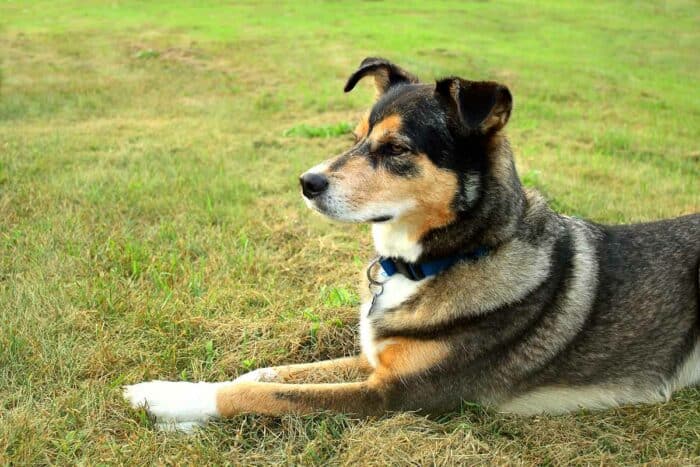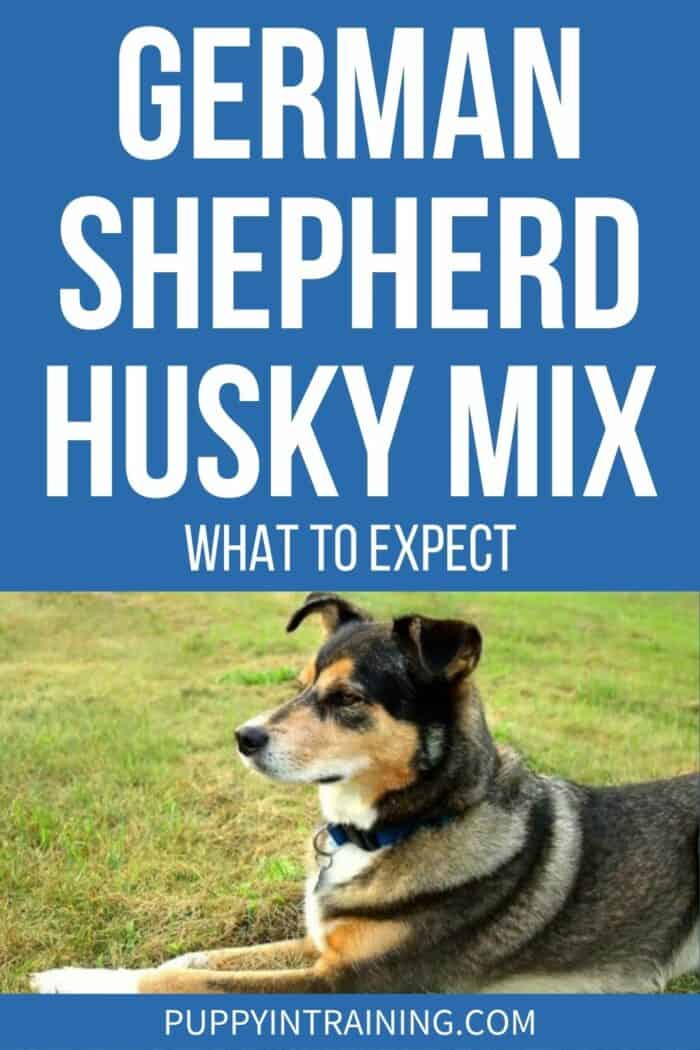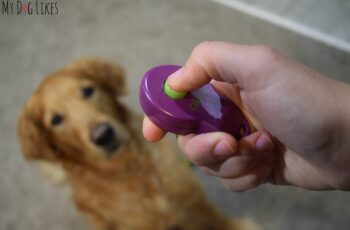This post may contain affiliate links. We may earn money or products from the companies mentioned in this post.
When you mix together an intelligent German Shepherd and a majestic Siberian Husky, you get a mix also known as a Shepsky or a Gerberian Shepsky.
Most dog owners hope to get an energetic and loyal medium-sized dog that inherits the best qualities of both parents.
While it is impossible to predict exactly how the characteristics of two parents will combine in a mixed-breed dog, experience suggests that you will get a fantastic working dog that will make a great addition to a boisterous family.

The breed does well in cold climates but will need lots of exercise and mental stimulation.
Let’s take a closer look at what exactly you can expect when you decide to adopt a German Shepherd Husky mix.
Looking for a Shepsky?
There are many German Shepherd Husky mixes available for adoption in shelters across the country.
As they are not purebred dogs, it can be difficult to purchase them from a breeder. Why not give a dog in need a happy home and adopt?
Read our guide to adopting from a shelter here.
Shepsky Principal Characteristics
- Height: 20-25 inches
- Weight: 40-80 pounds
- Lifespan: 10-14 years
- Activity levels: High
- Shedding levels: High
- Temperament: intelligent, eager to please
History Of The Shepsky
As we briefly noted earlier, “Shepsky” is a name for a dog that is a mix of the German Shepherd and Siberian Husky breeds.
While herding dogs were being bred in Germany throughout the 19th century, the first formally recognized German Shepherd was registered by Max von Stephanitz in 1899.
The dog, named Horand von Grafrath, was the result of several generations of selective breeding to create a working dog ideal for herding sheep.
Since then, because of the dog’s consistent strength, intelligence, trainability, and obedience, it has become a popular working dog for professions such as police, military, and search and rescue.
The German Shepherd has a very forceful bite, and they are often mischaracterized as aggressive and likely to harm humans.
However, while German Shepherds are responsible for a large number of canine attacks on humans, this is largely due to their popularity as pets and how abundant they are rather than any natural, breed-specific aggression.
German Shepherds are actually considered great family pets, and they are known to be very good with children, though they can also be somewhat overprotective..
The Siberian Husky, in contrast, comes from Northeastern Asia where they were bred by the Chukchi people of Siberia to pull sleds. The result is an active breed with a lot of endurance that just loves to run.
These dogs do very well in cold climates, and they were introduced to Alaska around 1900 as part of the Alaskan Nome Gold Rush.
While you will still find these dogs working in some frozen terrains, they are now popular household pets.
While they are energetic, friendly, and excellent with children, they are also troublemakers if not trained and socialized properly. They enjoy digging, chewing, jumping, and generally escaping any kind of confined space.
Both dogs are of a similar size and have a wolf-like appearance, which is part of what made them prime candidates for crossbreeding.
What Are Crossbred Dogs?
It is worth noting that crossbred dogs, sometimes called designer dogs, are dogs that have been intentionally bred by mixing two or more recognized breeds. It is not a term for dogs bred accidentally or without purebred ancestors.
However, crossbred dogs are not recognized as separate breeds in their own right, so their behavior and characteristics are not as predictable as purebred dogs.
One of the advantages of purebred dogs is that it is relatively easy to predict their size, appearance, and temperament.
While years of experience has given breeders a pretty good idea of what to expect with certain crossbreed dogs, the way that the characteristics of the two different breeds combine can be unpredictable and they do not always “breed true.”
One of the advantages of crossbred dogs is that they can be less prone to inherited genetic defects as there is more variation in their genetic pools.
Gerberian Shepsky Appearance
As both German Shepherds and Siberian Huskies are medium-sized dogs with a wolf-like appearance, you can expect similar traits from their offspring.
German Shepherds tend to be considered medium-to-large-sized dogs. Males typically measure 24 to 26 inches in height at the withers, and the females are usually a bit smaller at 22 to 24 inches.
However, both sexes tend to look bigger than other dogs of a similar height, as they have very long necks.
Siberian Huskies are a bit smaller, measuring between 19 and 24 inches and weighing between 35 and 60 pounds on average. The females are at the smaller end of the spectrum, and the males are at the larger end.
As a result, you can expect Shepskies to be around the smaller range for German Shepherds, with males ranging from 22 to 25 inches and females ranging from 20 to 24 inches in height.
When it comes to their weight, males tend to be between 50 to 80 pounds, while females weigh a bit less at 40 to 70 pounds.
Shepsky puppies tend to have a distinctive wolf-like appearance, with pointed ears and long noses inherited from both parents. Their eyes will either be brown or blue, and some individuals might have the distinctive dual eye color often associated with huskies.
Both parent breeds have a coat ideal for colder climates, so this is something that can be expected from their offspring. They typically have a dual coat with a dense, soft undercoat and another layer of more durable guard hairs on top.
As German Shepherds can have either medium-to-long outer coats, the same is true of their Gerberian Shepsky offspring.
The Shepsky’s coat can come in a wide range of colors, including brown, black, cream, white, and even shades of red and blue. They are almost never one solid color and will almost always be a mix of at least two different colors.
One thing you can expect from all Shepsky coats is that they will be high shedding. Anyone with an allergy to dog hair should be wary about adopting a Shepsky!
Gerberian Shepsky Temperament
German Shepherds are highly intelligent dogs, and they are also highly motivated to please, which makes them one of the most trainable dog breeds out there. This quality is also why they are such good working dogs.
Siberian Huskies are also very intelligent, but they are far more independent. They have been bred to make challenging decisions while running across dangerous arctic territories, so problem-solving is a necessary skill.
As a result, while your Shepsky will almost certainly be a very intelligent dog, they might be a bit more troublesome to train than a German Shepherd.
Some offspring might inherit their Husky parent’s need for constant stimulation, which can make them escape artists. Alternatively, they might choose to entertain themselves by digging or chewing.
Both breeds were created to spend a lot of time with humans, with Huskies often staying indoors with their families for warmth.
This means they tend to bond quickly with their people and are very good with smaller family members (though very small children should never be left unsupervised with any dog).
While German Shepherds tend to have guard dog-like protective instincts, Huskies are pack animals and enjoy the company of other dogs.
So, it is difficult to predict whether your Shepsky crossbreed will display more alpha-like behavior or be more submissive and play well with other pets.
Remember, proper socialization training can go a long way when it comes to ensuring that they play well with others regardless of their temperament.
Neither parent breed tends to bark excessively, but your Shepsky will get vocal if they want to alert you to a threat. Huskies tend to howl rather than bark, so keep in mind you might end up with a Shepsky with an adorable howl that may disturb the neighbors.
If you do find yourself with a barker, read our guide on dealing with excessive or nuisance barking.
Overall, expect your dog to be high energy, combining the herding instinct of a German Shepherd with the running mandate of a Siberian Husky.
These dogs need ample space to stretch their legs and aren’t suitable for apartment living. They also need a lot of human companionship and won’t be happy to be left home alone for hours on end.
Caring For A German Shepherd Husky Mix
Shepskies tend to be highly trainable, so an experienced dog owner should be able to train them at home using basic positive reinforcement training.
However, they aren’t necessarily recommended for first-time owners, since their size and strength can make them difficult to handle if something does go wrong.
They are relatively large dogs and tend to have a lot of energy, which means they aren’t ideal for apartment living or being left alone in small spaces.
Shepskies do best when they have a large backyard where they can spend their energy. Remember, they can be escape artists, which means they need a space that is securely fenced. Fences at least six feet tall are recommended.
In addition to having plenty of space, Shepskies need a lot of exercise. They should be taken outside at least twice a day for a minimum of 30-60 minutes at a time.
Dog parks where they can run around off-leash are ideal, as it lets them stretch their legs and burn off excess energy. Just make sure they have been properly socialized before letting them loose.
These dogs enjoy human companionship, so they won’t like to be left at home for long periods of time. They are not ideal pets for people who spend most of the week in the office or traveling for work.
Expect your Shepsky to engage in destructive behavior when they are feeling the stress of abandonment.
Shepskies tend to have fairly dry coats. Huskies do not have oily coats, and they will often pass this trait down to their crossbred children.
While this means they don’t tend to give off the same “dog smell” as other pups, it can also make them prone to dry skin and a dry coat. Avoid excessive washing to prevent drying them out further.
Regular brushing is advisable to remove shedding hair, since these dogs tend to shed a lot. This is both for their comfort and to make cleanup around the home a little more manageable for you.
Shepsky Health Concerns
Shepskies have a relatively long lifespan for dogs of their size, and you can expect them to live for around 10 to 14 years.
While they tend to be healthier than their purebred parents, there are a few common health conditions to look out for if you’re considering adopting one of these dogs.
Shepskies can develop joint conditions, particularly in their elbows and hips, which can lead to pain and discomfort moving as they age.
Adequate exercise and an orthopedic bed that allows them to take the pressure off their joints are both useful tools in preventing these issues.
This unique crossbreed can also be prone to developing eye conditions such as canine glaucoma, corneal dystrophy, juvenile cataracts, and progressive retinal atrophy. Losing at least some of their eyesight in later life is a common concern.
German Shepherd Husky mixes are also slightly more susceptible to developing epilepsy than most other breeds, though the condition is still relatively rare. Medications exist to help manage this condition.
The Shepsky’s big ears mean they may also develop ear infections on a relatively frequent basis. This can be prevented with regular cleaning and maintenance. Our black Lab Stetson had chronic ear infections and we used and recommend Virbac Epi-Otic Advanced Ear Clear for Dogs.
Gerberian Shepsky FAQs
How much are Gerberian Shepskies worth?
You might be able to find a Gerberian Shepsky in a local shelter to adopt for a small fee, or you can opt to find a dedicated Shepsky breeder.
If you choose the latter, you can expect to pay anywhere from $400 to $1,200 depending on where you live and the quality of the breeder.
If you are intending to buy your dog from an experienced Shepsky breeder that is controlling for characteristics such as eye color and temperament, you can expect to pay around $1,000 for your pup.
Do Gerberian Shepskies shed a lot?
Yes, German Shepherd Husky mixes shed a lot, and there is no getting around it. Both parent breeds have a thick winter coat that is prone to shedding, so this is a common characteristic in their offspring.
If you are looking for a medium-sized low shedding dog, consider something with the Poodle breed in the mix, such as a Labradoodle or Goldendoodle. Poodles have a low-shedding coat that they typically pass on to their crossbred offspring.
Do German Shepherd Husky mixes smell?
While this varies, many Shepsky owners have noted that the dog doesn’t have a typical musky “dog smell.”
This is because Huskies do not have an oily coat, and those natural oils are largely responsible for that characteristic odor. Many Huskies pass on their low-oil coat to their crossbred offspring.
If you do adopt a Shepsky, remember not to bathe your dog too regularly. The lack of oil can make them prone to having dry skin, and excessive washing can exacerbate this problem.
Do Shepskies get cold?
Siberian Huskies were bred to deal with extreme cold, and German Shepherds also have a thick coat to deal with colder temperatures.
This means their offspring are very well insulated against the cold, and you will almost never have to worry about them being uncomfortable in colder temperatures.
Overheating, however, can be an issue, so always carry water when you go out. You will probably find that your Shepsky prefers to relax in cool, shady areas.
What is an Alusky?
An Alusky is a mix between a Siberian Husky and an Alaskan Malamute. This is a very popular designer breed, as they often have distinctive black and white patterning as well as an overall wolf-like appearance.
What dog breeds are commonly mixed with Huskies?
As well as German Shepherds, you will find a number of other dog breeds that make a good mix with a Husky. These include the Alaskan Malamute, Corgi, Boxer, Pomeranian, and American Eskimo dogs.
The Verdict On Shepskies
If you are looking for a fun and energetic dog that will make a great addition to a boisterous and adventurous family, then a German Shepherd Husky mix can be a great choice.
Shepskies are very family-friendly pets that are loyal and highly trainable, but they also need lots of love and attention to keep them healthy and happy.
They have a distinctive wolf-like appearance, but are far from aggressive and are generally very good with children. However, they are known for their delightful wolf-like howl.
Remember that crossbreed dogs are always somewhat unpredictable in their appearance and temperament, so ensure that you meet the dog you plan on adopting first before deciding whether to add them to your family.
Shepskies are best for people who have quite a bit of space for their dog to play and usually have someone to keep them company at home.
You will enjoy training your Shepsky yourself if you have a bit of experience with dogs, but steer clear if you have allergies, as they are big shedders!
Do you have any experience raising a German Shepherd Husky mix?
Share your thoughts with the community in the comments section below.
Save To Pinterest

Top Picks For Our Puppies
- BEST PUPPY TOY
We Like: Snuggle Puppy w/ Heart Beat & Heat Pack – Perfect for new puppies. We get all of our Service Dog pups a Snuggle Puppy. - BEST DOG CHEW
We Like: Best Bully Sticks – All of our puppies love to bite, nip, and chew. We love using Bully Sticks to help divert these unwanted behaviors. - BEST DOG TREATS
We Like: Wellness Soft Puppy Bites – One of our favorite treats for training our service dog puppies. - BEST FRESH DOG FOOD
We Like: The Farmer’s Dog – A couple months ago we started feeding Raven fresh dog food and she loves it! Get 50% off your first order of The Farmer’s Dog.
Check out more of our favorites on our New Puppy Checklist.


